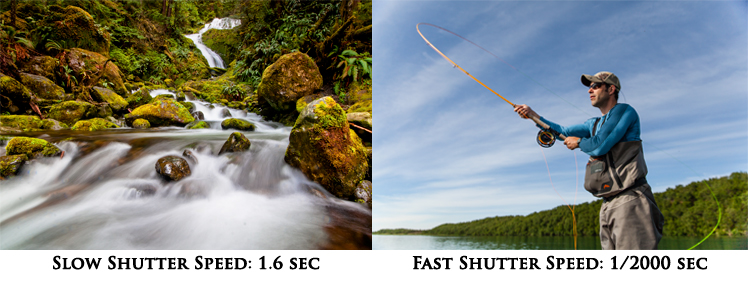Fishing Photography - Understanding Your Camera's Priority Modes
I think taking on full manual control of a camera is a goal for any aspiring photographer looking to improve their skills. While it is very intimidating at first, learning manual control can be taken one step at a time through the use and understanding of the camera’s preset priority modes. In the last “Behind the Lens” article we discussed choosing the proper lens for your fishing photography. Building on that, I will briefly discuss using priority modes in preparation for takingon full manual control of your cameras settings.
Shutter Priority -
Outside of full manual control, using your cameras shutter priority mode (“S” on Canon or “Tv” on Nikon) is the best way to learn how to control the amount of movement and/or blur produced in your final image. Here, your camera allows you to choose the desired shutter speed, while it takes control of the remaining ISO and aperture settings. When trying to capture fly line in flight, or a fish doing mid-air cartwheels, you will find that cranking up the shutter to the maximum possible speed is necessary to get a sharp, clean image. While this is not exactly rocket science, it is necessary to understand completely. I can hold my camera steady at a shutter speed of 1/60th or faster by hand, but if I need to shoot any slower, a camera support is necessary to avoid blur in the final image.
The downside to using the shutter priority mode lies in the photographers inability to set the desired depth of field. Keeping this limiting factor in mind, I always enjoyed experimenting with the shutter speeds when trying to capture a fly line in flight. I would start at a low shutter speed, and continuously analyze how “frozen” the line and angler were as the speed was ramped up. Over time I realized that sometimes a little blur is a good thing, giving the image a sense of movement and action that a completely still frame does not have.

Aperature Prority
In Aperture mode (“A” on Canon and “Tv” on Nikon,) the photographer chooses the desired depth of field and allows the camera sensor to dictate the shutter speed and ISO. This allows more control over what I refer to as the “focus” of the image. More simply put, as the F-stop value is increased, more of the frame comes into focus.
I believe that understanding how to control the depth of field is a place where one can grow the most as a photographer. Aperture priority was hands down my favorite mode when I was learning how my camera settings worked together. While shutter speeds are fairly straight forward, controlling what’s in focus and the general feel of the image is really up to the personal styling of the photographer.

Taking on Manual Mode.
Using the lessons learned from shooting in the cameras priority modes, I began to understand the aperture and shutter settings necessary to achieve my desired effects. The final part of the equation lies in adjusting the ISO value accordingly, which allows for the proper exposure. If the image is too bright, the ISO value needs to be lowered, and if the image is too dark, the value needs to be increased.
Ultimately, the difference in ISO values can be seen in how pixelated an image will be when blown up into a larger size. The lower the ISO number, the clearer the image will be. Most newer DSLR cameras, and even most point and shoot models, use some truly amazing technology providing for some great quality images even when using higher than normal ISO settings.
Learning manual mode will take a bit of time, but is hands down the best thing you can do to improve your photo skills. I feel that working up to full manual control in this manner is the easiest way to comprehend how shutter speed, aperture, and ISO work together. Fortunately, this is best done through experimentation and practice, so get out on the water and snap away. I bet you will be delightfully surprised with your results.
